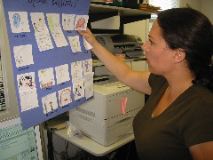Learning from our conversations in English: Using video in the bilingual classroom as a tool for reflection on English language learning and teaching
Sarah
Capitelli, Melrose Elementary School, Oakland CA
with Desiree Pointer, Knowledge Media Lab, The Carnegie
Foundation
How we learned from our conversations in English:
- Overview
- What structures support English language development in my classroom?
- How do conversations between students support English language learning?
- What strategies do good English language learners use?
- How can video be used to give my students a window into their English language learning?
- Next steps
Context
Class Materials
Resources
 Next
Steps: What I'm thinking about now
Next
Steps: What I'm thinking about now
Although my inquiry this year gave me many new insights into my teaching and my students, I am always left with more questions about myself, my teaching and my students than I am with answers. I was particularly struck with the questions I began to ask myself about my role in teaching English grammar and structures during ELD class. So much of my practice in the past has been focused on the development of oral language with a strong focus on listening and speaking tasks. One of my assumptions was that low English proficiency students and students who were still developing their fluency in their primary language were not ready to learn English grammar and structures. Another assumption that I had been working under was that oral language development through listening and speaking tasks was antithetical to the instruction of English grammar and structure. My lessons were designed to encourage and support the production of English. Including instruction around grammar and structures might discourage students from taking risks with oral language and ultimately be counterproductive to learning English. There was plenty of time later to learn grammar and focus on language structures. The use of video allowed me to see the importance of both: the big pictures plus all of the pieces that make up the big picture. Using the video with the students also made me aware of how aware they are of the pieces that they are struggling with. Both the high and low proficient students recognized that they were struggling. They may not have always known what to call what they were struggling with but I was able to see that it was a struggle with pronouns or possessives or verb tense.
I am continuing with my inquiry into my ELD class this year better informed about my practice and our school’s program from my work last year and the years before. At the center of all of the work I am doing with my ELD class is my concern with how to best meet the needs of all of my ELL. Given this concern I will continue to study my own ELD practice. I am beginning the year by challenging the assumptions that I have been holding about English language grammar and structure instruction. It is the challenging of these assumptions that helps me to frame the questions I am now asking: What is the relationship between oral language development and the learning of English language grammar and structure? How can student conversations impact English language grammar and structure development?